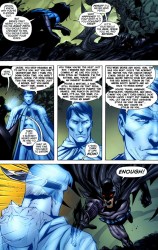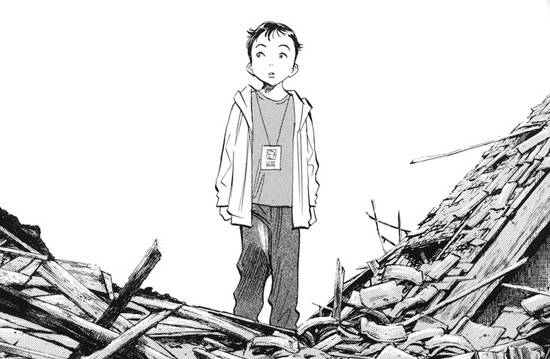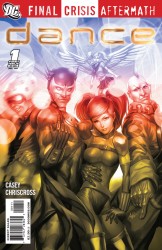
Is this a comeback?
May 23rd, 2009 Posted by david brothersNo idea, but Gav told me to do this.

From the ever-classic rap battle.

No idea, but Gav told me to do this.

From the ever-classic rap battle.

Rafael Grampa’s Batman & Robin, that is. I found this via Sean Witzke, who found it via Grampa’s flickr.



I read Pluto: Urasawa x Tezuka, Volume 1 a few weeks back, and received volumes 2 and 3 from Amazon last week. I’m going to give the series a thorough review later, but I wanted to talk about something that leapt out at me in Volume 2
. Pluto is Naoki Urasawa’s re-telling of a classic Osamu Tezuka tale, The Greatest Robot on Earth. It was the story of a robot killer named Pluto who wanted to destroy the 7 greatest robots on Earth. Deb Aoki of About.com explains the deal here. Urasawa is the man who created Monster, one of my all-time favorite books.
I’m not exactly familiar with Astro Boy. I know the basics, but I don’t know that I’ve ever seen a movie or tv series, or even read the originals. So, for me, Pluto is an introduction to both Astro Boy/Atom and Tezuka himself. Bear with me if this is something you’ve heard before.
 While reading Pluto v2, I realized that Atom is what happens when Pinocchio gets to be a real boy, while Gesicht, the inspector and star of the book, has only gone partway down that path. It was a gut feeling that struck me when Atom scanned Gesicht’s memory chip. Rather than discussing what he saw that bothered him, he came up with an excuse to go to the bathroom, where he began bawling his eyes out. That scene quickly became one of my favorite scenes in comics. I’ve had comics that are purely emotionally manipulative, but this scene was honest and extremely sad.
While reading Pluto v2, I realized that Atom is what happens when Pinocchio gets to be a real boy, while Gesicht, the inspector and star of the book, has only gone partway down that path. It was a gut feeling that struck me when Atom scanned Gesicht’s memory chip. Rather than discussing what he saw that bothered him, he came up with an excuse to go to the bathroom, where he began bawling his eyes out. That scene quickly became one of my favorite scenes in comics. I’ve had comics that are purely emotionally manipulative, but this scene was honest and extremely sad.
That moment, when combined with the anti-robot bigotry of a police detective and probing questioning from Gesicht, made me realize why Atom is a “real boy,” despite being wholly artificial. The bigoted detective kept asking Atom questions, trying to prove that robots can’t feel genuine emotion or appreciate beautiful things. Gesicht wasn’t as rude as the other detective, but he also wanted to know about Atom’s feelings.
Both detectives want Atom to quantify these very fleeting feelings as a way of either proving his humanity or his robothood. “Do you really feel that? What is this like? You can’t appreciate this, can you?” Atom can’t articulate what these feelings mean. Either he can’t pin them down or he doesn’t know. Either way, he can’t express how the emotions work or what effect they have on him.
However, humans are the same way. We have dozens, if not hundreds, of ways to say that food tastes good. There are high level ways to say it. Food is delicious, tasty, appetizing, or succulent. There are more specific ways, as well. Food can be spicy, tangy, sour, or sweet. If you asked someone to describe why they liked pepperoni pizza, they’d probably use some of these words. If you asked them to describe why the spicy pepperoni tastes good, what would they say?
Can you turn “I like it” into something quantifiable? What about love? Art? I think that you can approach it, and you can certainly give reasons why, but when it comes down to it, you like things because you like them. They touch something inside of you. You can try to figure out exactly why and explain it to others, but you can’t communicate some things. You can only approach it. Describing “sad” as a bio-chemical reaction in your brain is one thing, but does it actually cover “sad”?
Judging by Urasawa’s other work, this reading is almost definitely intentional. Atom can’t articulate certain things inside him, and he isn’t human, but he is not human in a way that all humans are not human. He can’t reliably articulate the same things we can’t, and that is what makes him human.
Gesicht is the opposite. He’s a robot who wants to know all about how Atom isn’t a robot, and how that relates to Gesicht’s own robothood. He’s picking Atom’s brain to see where he stands.
He’s essentially a Pinocchio who hasn’t realized that he is a real boy. Where Atom knows that he’s a robot and accepted “fake it until you make it” as something he can do, Gesicht isn’t comfortable with faking it, and therefore isn’t comfortable in his own humanity.
Obviously, I’m only two books into a multi-part series, but at the moment, I’m completely fascinated by Atom. Everything about him, from his tousled hair and innocent looks to the contrast between his robotic skills and very human demeanor makes him a character that I just have to see more of.

Jack Johnson was the son of two slaves and one of the greatest boxers who ever lived. He entered a sport that had previously been the province of white males and dominated. It’s probably fair to say that he was one of the first high-profile black athletes. He had endorsement deals, interviews, and was probably even the originator of black athletes marrying white chicks (no oj simpson). He may have been a little more Mike Tyson than Muhammad Ali, but the man’s skills were undeniable. You couldn’t ignore him if you wanted to.
A lot of people probably wanted to ignore him. Jack was loud, brash, and could lean almost anybody who stepped into the ring. He was a demolisher, and he’s the reason why the idea of a “Great White Hope” exists. His wins were seen as a genuine insult to many people of the time, to the point that James Jeffries came out of retirement for the express purpose of putting him down to show that whites were better than blacks. Spoiler: Jeffries lost in the 15th.
Jack Johnson was a monster, and an inspiration to many. The relationship between blacks and sports has often been a contentious one, but it’s also one that’s given many a kid hope for the future. Heroes are heroes, and if you see someone like you doing something amazing, that sticks with you.
Why am I talking about this? A friend pointed me to a Miles Davis album last night, “A Tribute to Jack Johnson.” Two tracks, 50 minutes of music. I figured I’d hop on AmazonMP3 and buy it. Once I got there, I found a surprise. Click this picture.

So order A Tribute To Jack Johnson and find me somebody who wants to draw, or has drawn, a comic about black boxers.

Cheryl Lynn has another entry in her Black Trinity run. This time, it’s on Martha Washington, one of my favorite characters, as the Black Reality.
For the Black Reality is that you have to work twice as hard to get half the recognition. Martha works four times as hard and gets all of it. She saves her country numerous times. She exposes her detractors for the dangerous and deluded beings they are. Not for glory, but because her will and desire for freedom is simply that strong. She is that special.












Lone Wolf and Cub volume 1: The Assassin’s Road
Writer: Kazuo Koike
Artist: Goseki Kojima
Publisher: Dark Horse Comics
ISBN: 1569715025
296 pages
Before I get into talking about the book, I want to take a moment and compliment the translation team for Lone Wolf & Cub. Dana Lewis is credited with “translation,” and a brief google search reveals that Lewis is/was a part of Studio Proteus, one of the main forces that helped bring manga into the mainstream here in the States.
The translation is an adaptation, rather than a word-for-word find/replace job. It takes into account that certain things simply can’t be translated into English or American culture, and adjusts accordingly. Specific terms are often left in their original Japanese, and a combination of context and a solid glossary at the back help to explain what’s going on. There are also a few moments of re-contextualization in the text. One chapter ends with a woman looking on at Ogami and Daigoro as they cross a river. She says, “A baby carriage… on the river Sanzu.” The Sanzu River means nothing to most American readers, but the title of the chapter, “Baby Cart on the River Styx” provides a context clue. While the river Styx isn’t 100% the same as the river Sanzu, the basic idea is the same. The father and son are both caught on the path of the doomed and the dead. It’s an idea that’s repeated fairly often throughout the book, both from Ogami’s mouth and those of the people he encounters.
I knew many of the broad strokes going in due to a passing interest in Japanese history. Iga and Koga ninja, the Yagyu clan, Tokugawa shogunate, and a fistful of other terms will be familiar to anyone who has spent any amount of time partaking in anything that involves samurai or ninjas, from history books to manga to anime.
Japanese history tends to pop up everywhere in their pop culture. Amakusa Shiro is a popular villain in anime and video games, most notably Samurai Shodown. Yagyu Jubei has been presented more than once as the samurai equivalent of Marvel’s Nick Fury, from the eyepatch down to the war hero status and career as a spy. I don’t know that American culture can really compare. I’ve seen very little popular fiction starring George Washington or Benjamin Franklin, and I don’t think any of it has resulted in the same penetration that Japanese historical figures have. It’s fascinating.
Lone Wolf and Cub: The Assassin’s Road contains nine stories. “Son for Hire, Sword for Hire,” “A Father Knows His Child’s Heart, as Only a Child Can Know His Father’s,” From North to South, From West to East,” “Baby Cart on the River Styx,” “Suio School Zanbato,” “Waiting for the Rains,” “Eight Gates of Deceit,” “Wings to the Birds, Fangs to the Beast,” and “The Assassin’s Road” make up just a hair under 300 pages of samurai action.
Read the rest of this entry �

 DC’s The Source blog put up a preview of the new Joe Casey/Chriscross joint, Final Crisis Aftermath: Dance.
DC’s The Source blog put up a preview of the new Joe Casey/Chriscross joint, Final Crisis Aftermath: Dance.
FINAL CRISIS AFTERMATH: DANCE #1
Written by Joe Casey
Art by ChrisCross
Cover by Stanley “Artgerm” Lau
Japan’s Super Young Team wants nothing more than to be seen as heroes in the eyes of their adoring public. Unfortunately, their adventures during FINAL CRISIS have gone unnoticed, and they’ve been reduced to performing at public appearances and on various TV shows literally dancing for their livelihood. But the appearance of a new American teammate and a deadly threat complicates the motives of the team as they try and find what truly makes somebody not just a hero, but a sensational hero. Discover the path to greatness in this exciting 6-issue miniseries!
Even better, Brandon Thomas interviewed Joe Casey about the book and his other work. Casey is off Youngblood, so I’m off that book, too. Plus, he says something I agree with 100% on Obama comics:
JC: No way. That move is so played out. Let the guy be the President now, for chrissakes. I think he’s all through being a cheap marketing ploy, a shortcut to making a quick blast of cash in the Direct Market, don’t you?

I’ve been using Comixology to handle my pull list. They’ve got a pretty robust pull list feature going on, and it integrates with my comic shop, so it’s very convenient. Adding and subtracting things is just a matter of pressing a button. I dig it. Check it out, you might, too.
I pulled up my pull list to see how many books I’m regularly buying. This doesn’t count things I grab off the shelf, but it’s a pretty good representation of what I buy.
Marvel- Amazing Spider-Man #593
Vertigo- Seaguy: The Slaves of Mickey Eye #2 (of 3) (MR)
Marvel- Black Panther Vol. 2 #4
Vertigo- Young Liars #15 (MR)
Marvel- Amazing Spider-Man #594
DC Comics- Final Crisis Aftermath: Dance #1 (of 6)
Vertigo- Hellblazer #255 (MR)
Marvel- Amazing Spider-Man #595
Marvel- Immortal Iron Fist #26
Vertigo- Unknown Soldier #8 (MR)
That’s the entire month of May for me. Eight distinct franchises, a total of ten comics. That comes up to a hair over 30 bucks a month on average.
I pared my pull list down a lot over the past few months. I vastly prefer trades, and DC has done a pretty good job of chasing me away from a lot of books. In fact, I think I buy two main DCU books– Power Girl and Dance. I’m waiting for Batman & Robin to come back, and the Rucka/JHW3 Detective might pull me in depending on how the first issue goes. In fact, just looking at May… I’m not really bothering with the big events from either company. Final Crisis Aftermath counts, I guess, but I expect that to be good, unlike Battle for the Cowl or the other Aftermath books. It’s the only one that sounded appealing to me, anyway.
I made a decision a while back not to buy books I felt were mediocre. If I’m not loving it, or at least liking it a whole lot with a chance of love, I’m not buying it. Life’s too short to read bad comics, and if a comic isn’t pushing my buttons, that’s the very definition of a bad comic. The way my list is now, I really look forward to picking up my books. I know I’ll get a couple of books a week that’ll float my boat.
What’s your pull list looking like? Are you policing your stack by quality or price? I generally don’t buy 3.99 books as a rule, unless it’s genuinely extra sized, as in Amazing Spider-Man’s special issues.